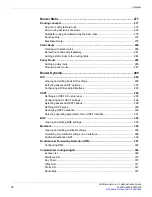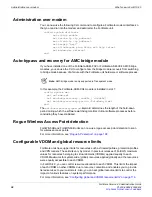
Document conventions
Introduction
FortiGate Version 4.0 Administration Guide
24
01-400-89802-20090424
•
provides information about the tunnel-mode and route-based (interface
mode) Internet Protocol Security (IPSec) VPN options available through the web-
based manager.
•
explains how to use the web-based manager to specify a range of IP
addresses for PPTP clients.
•
provides information about basic SSL VPN settings.
•
describes how to control access to network resources through user
authentication.
•
WAN optimization and web caching
describes how to use FortiGate units to improve
performance and security of traffic passing between locations on your wide area
network (WAN) or over the Internet by applying WAN optimization and web caching.
•
describes how to use FortiGate end point control to enforce the use of
FortiClient End Point Security (Enterprise Edition) in your network.
•
describes how to enable logging, view log files, and view the basic reports
available through the web-based manager.
Document conventions
Fortinet technical documentation uses the conventions described below.
IP addresses
To avoid publication of public IP addresses that belong to Fortinet or any other
organization, the IP addresses used in Fortinet technical documentation are fictional and
follow the documentation guidelines specific to Fortinet. The addresses used are from the
private IP address ranges defined in RFC 1918: Address Allocation for Private Internets,
available at
http://ietf.org/rfc/rfc1918.txt?number-1918
CLI constraints
CLI constraints, such as
<address_ipv4>
, indicate which data types or string patterns
are acceptable input for a given parameter or variable value. CLI constraint conventions
are described in the CLI Reference document for each product.
Cautions, Notes and Tips
Fortinet technical documentation uses the following guidance and styles for cautions,
notes and tips.
Caution:
Warns you about commands or procedures that could have unexpected or
undesirable results including loss of data or damage to equipment.
Note:
Also presents useful information, but usually focused on an alternative, optional
method, such as a shortcut, to perform a step.
Tip:
Highlights useful additional information, often tailored to your workplace activity.
Summary of Contents for Gate 60D
Page 705: ...www fortinet com...
Page 706: ...www fortinet com...































